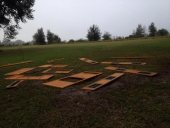


Ann Torrence wrote:Here at the ranch we declared 2016 the "year of data." Thus I'm formatting a new garden journal/homestead record book PDF for 2016. There are loads of examples on the internet for annual vegetable gardens. And I've worked out a good start on animal husbandry. But I haven't seen anything that inspires me for record-keeping of perennial gardens. What do I want to know? Bloom date, annual yields at minimum. Holistic spray logs. Observational notes.
I already have in my PDF design a harvest log, and an idea for a cool bloom table/chart. One thing I want to track is whether we have sufficient cross-pollination in our fruit crops so I want the bloom log for sure. It would be ideal, but I'm not sure I can keep up with a system that requires a cultivar by cultivar record-keeping system. We already have 75+ varieties of apples alone. That sounds like Newton's diary, no time for that.
But whatever I do, it's going to have to be somewhat separate from the annual records, because we want on-going data. Did pruning in week 10 in 2015 but not until week 12 in 2016, that kind of stuff. I'm thinking to use a weekly observation log in the 2016 homestead recordbook that gets transferred during the winter down time to a long-term permaculture record. How does your mind work? Would you prefer such a tool organized by zone or planting bed, where you might replicate data for the same plant (say chives) in two or three zones? or by plant, regardless of zone? Or some other way? If you had 200 perennial types, how many would you really track?
If it's a PITA, it won't get used, so the system has to be simple. Anyone seen any brilliant solutions? Digital or paper-based?
I wish this was a post for suggesting something; but, it isn't. We are just getting started and would love to see what you come up with.
Nick Garbarino wrote:The plant list for our food forest was posted 4 days ago, and so far it has been downloaded 33 times. Since there appears to be some interest, I have posted our newest version, which now includes fields for water, sun, pH, and root structure. The selection of plants has also been improved, with many additions and a few deletions. This list is particularly designed for Zone 9A, where the soil is sandy, dry, and acidic, however many of the plant selections could work in other zones, particularly zones 8 and 10.
There are many other plants that could be grown in our area, but which I left off for various reasons, especially if I suspect those species would need baby sitting in order to flourish here in central Florida. We are willing to use some well water for the critical and highly prized members of the food forest, such as citrus and blueberries for example, but we are trying to design a fairly drought tolerant community overall. So, there are many sub-tropical species that could grow here, but we're leaving them out because they're too thirsty.
I want to encourage any feedback that would improve this list, such as corrections, additional plants, removal of plants, etc. I could use all the help I can get. So, for those of you who downloaded the old list, throw it away and use this one instead. It's a lot better list.

